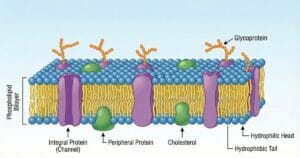
COMPETITIVE EXAM MCQs SERIES of ENVIRONMENTAL SCIENCE for UGC-NET/JRF, SLET, ARS, GATE, and other entrance tests – Environmental Geosciences – Earth’s Thermal Environment and Seasons.
Syllabus Outline
- Introduction to the Earth’s thermal environment.
- Heat transfer mechanisms (e.g. conduction, convection, and radiation).
- Energy balance of the Earth and the greenhouse effect.
- Distribution of solar radiation and concept of seasons and climate.
- Solar geometry, factors influencing radiation receipt, and measurement techniques.
- The Earth’s energy budget and the role of albedo.
- Atmospheric effects on solar radiation (e.g. scattering, absorption, and atmospheric components’ influence).
- Variation of solar radiation and temperature, and global climate patterns.
- Heat transfer processes within the Earth, thermal properties of Earth materials, and also their applications in geothermal energy and subsurface characterization.
- Climate change and its impacts on Earth’s thermal environment.
This quiz contains the concept-based most frequently asked 25 MCQs of “Environmental Geosciences – Earth’s Thermal Environment and Seasons“. Each question has a single correct/most appropriate answer.
*****
1. How does albedo influence Earth’s energy balance?
a) By absorbing outgoing thermal radiation
b) By enhancing greenhouse gas concentrations
c) By increasing atmospheric pressure
d) By reflecting incoming solar radiation
2. The phenomenon of air drainage in hills and mountains is primarily caused by:
a) Convection currents
b) Adiabatic cooling
c) Gravity
d) Coriolis effect
3. Which of the following phenomena is responsible for the seasonal changes in temperature on Earth?
a) Earth’s magnetic field
b) Axial tilt
c) Eccentricity of Earth’s orbit
d) Precession of the equinoxes
4. How does Earth’s tilt affect its thermal environment and seasons?
a) It has no impact on Earth’s thermal environment.
b) It causes variations in the intensity of solar radiation received at different latitudes.
c) It leads to a decrease in the overall planet temperature.
d) It results in uniform distribution of solar energy across the globe.
5. The main reason why the Earth experiences highest temperatures in the subtropics in the northern hemisphere rather than at the equator is:
a) Subtropical areas have an enhanced greenhouse effect compared to equatorial areas
b) Subtropical areas are nearer to the oceanic than the equatorial locations
c) Subtropical areas have longer day hours in the summer than the equatorial
d) Subtropical areas tend to have less cloud cover than equatorial areas
6. Which of the following factors primarily determines the temperature distribution on Earth’s surface?
a) Ocean currents
b) Altitude
c) Latitude
d) Longitude
7. In which layer of the Earth’s atmosphere does the absorption of incoming solar radiation occur majorly?
a) Thermosphere
b) Troposphere
c) Stratosphere
d) Mesosphere
8. Which atmospheric circulation cell is key in redistributing heat from the subtropics towards the poles?
a) Polar jet stream
b) Ferrel cell
c) Polar cell
d) Hadley cell
9. What factors primarily determine Earth’s albedo?
a) Atmospheric composition and thickness
b) Latitude and longitude
c) Ocean currents and wind patterns
d) Surface type, colour, and texture
10. The altitude, latitude, and period for which the mean temperature is calculated are important factors in:
a) Selecting a meteorological observatory for temperature data collection
b) Determining the range of temperature between January and July
c) Calculating the daily mean monthly temperature
d) Understanding the processes through which the earth-atmosphere system maintains heat balance
11. The process in which cold air at hills and mountains flows down the slope under the influence of gravity is known as:
a) Air drainage
b) Specific heat
c) Solar radiation
d) Inversion
12. Which of the following factors determine the temperature of a place?
a) Longitude and pressure
b) Humidity and wind speed
c) Latitude and altitude
d) Ocean currents and vegetation
13. What is the term for the process by which Earth’s surface absorbs incoming solar radiation and re-radiates it as heat?
a) Convection
b) Conduction
c) Insolation
d) Radiation
14. Assertion (A): Atmospheric circulation patterns are crucial in redistributing heat across the Earth’s surface.
Reasoning (R): Warm air rises at the equator, creating low-pressure areas, while cold air sinks at the poles, creating high pressure, resulting in the movement of air masses.
a) Both the A and R are true, but the R is not a correct explanation of the A.
b) The A is false, but the R is true.
c) The A is true, but the R is false.
d) Both the A and R are true, and the R is a correct explanation of the A.
15. The concept of albedo refers to:
a) Scattering of solar radiation by clouds
b) Transmission of solar radiation through the atmosphere
c) Reflection of solar radiation by the Earth’s surface
d) Absorption of solar radiation by the Earth’s surface
16. Which feedback mechanism amplifies initial climate changes by increasing the Earth’s temperature?
a) Ice-albedo feedback
b) Carbon cycle feedback
c) Ocean circulation feedback
d) Solar radiation feedback
17. Which process involves the transfer of heat through direct contact between molecules?
a) Conduction
b) Convection
c) Insolation
d) Radiation
18. Which atmospheric circulation pattern redistributes heat from the equator towards the poles?
a) Jetstream
b) Hadley cell
c) Ferrel cell
d) Polar cell
19. Thermal inversions commonly occur in which types of geographic locations?
a) Mountain valleys
b) Coastal regions
c) Desert plains
d) Polar regions
20. The unequal distribution of heat over the planet Earth in space and time causes variations in weather and climate due to the:
a) Differences in the amount of solar radiation received
b) Air drainage
c) Pressure differences in the atmosphere
d) Specific heat
21. The process through which the Earth-atmosphere system maintains heat balance primarily involves the exchange of energy through:
a) Radiation
b) Advection
c) Conduction
d) Convection
22. The latitude and the tilt in the axis of rotation of the earth affect the amount of radiation received at the earth’s surface by:
a) Causing air drainage
b) Affecting the heating and cooling of the atmosphere
c) Determining the angle at which solar radiation strikes the earth
d) Influencing the distribution of surface air temperature
23. Assertion (A): Thermal inversions occur when a layer of warm air traps cooler air near the Earth’s surface.
Reasoning (R): Thermal inversions are more likely to happen during clear, calm nights when the ground loses heat rapidly.
a) Both the A and R are true, and the R is a correct explanation of the A.
b) The A is false, but the R is true.
c) The A is true, but the R is false.
d) Both the A and R are true, but the R is not a correct explanation of the A.
24. The distribution of temperature on Earth’s surface is primarily influenced by:
a) Atmospheric pressure gradients
b) Solar declination angles
c) Latitudinal variations in insolation
d) Ocean salinity levels
25. The deviation from the general trend of isotherms parallel to latitude is more pronounced in which hemisphere?
a) Tropics
b) Southern hemisphere
c) Northern hemisphere
d) Equatorial region
*****
Previous: Identification and Characterization of Clay Minerals
Next: Geochemical Classification of Elements
References
- Ahrens, C. Donald (2012) Meteorology Today: An Introduction to Weather, Climate, and the Environment, Cengage Learning, 10th edition.
- Tarbuck, Edward J., Lutgens, Frederick K., and Tasa, Dennis G. (2017) Earth Science, Pearson, 15th edition.
- Singh, R. B., and Sinha, R. K. (2017) Environmental Science: Earth as a Living Planet, Khanna Publishers, 1st edition.

